In June, we recorded the highest number of illegal bushmeat poaching and logging incidents since the inception of Mara Elephant Project. The pressures put on the economy have increased due to the effect of COVID-19 on the tourism industry. The halt of tourist generated revenue in the Mara has meant more people are out of work, which results in food insecurity and an increase in illegal activities. MEP is combatting this head on by deploying our partnership model and working closely with Kenya Wildlife Service (KWS), Kenya Forest Service (KFS) and Mara North Conservancy (MNC) within the Maasai Mara ecosystem. The three forest areas we work in are taking a real hit with the increase in illegal activities and as a result, we’ve increased our efforts to meet this upsurge all while keeping our rangers safe and working closer than ever with our government law enforcement partners.
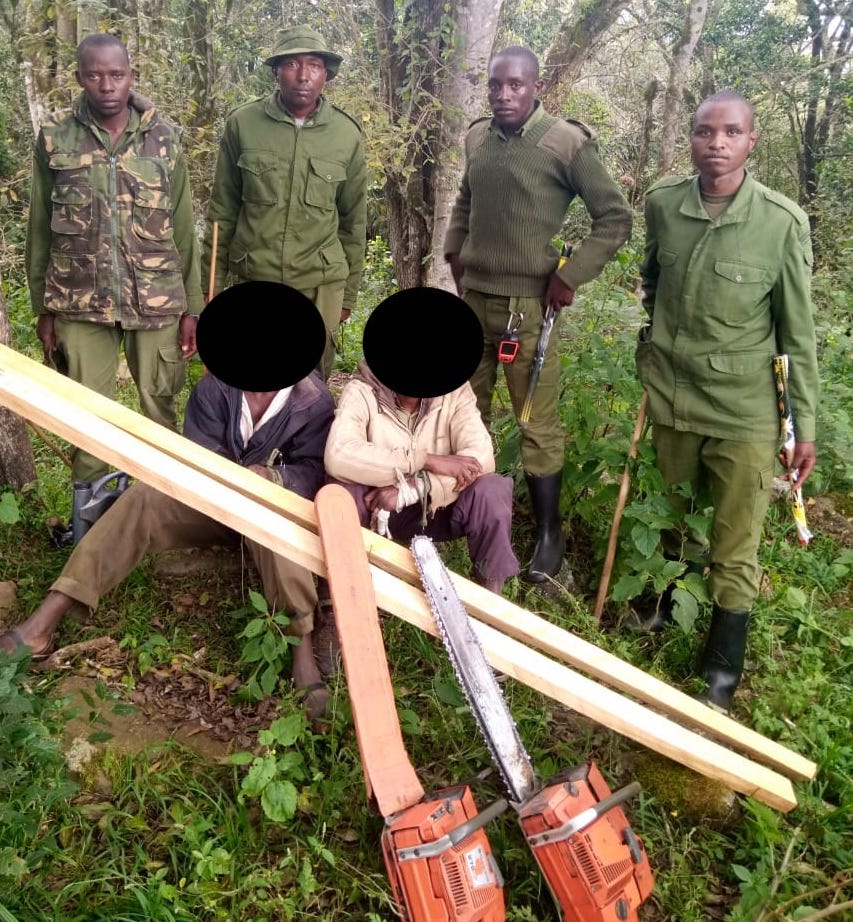
The Loita team arrested two suspects with power saws cutting down a podo tree.

One suspect was arrested on June 20 in the Mau Forest by the Sheldrick Wildlife Trust Mau De-Snaring Unit with 20 kg of bushmeat. The team removed 21 snares that day in the Mau.
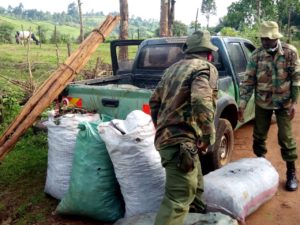 In total in June, MEP rangers along with partners confiscated 2,980 illegal timbers and posts, five power saws, 20 kg of bushmeat and arrested 24 people for illegal activities related to deforestation and one bushmeat poacher. They also destroyed 28 kilns, 248 sacks of charcoal and removed 43 snares. (pictured left: On June 22, rangers ambushed a vehicle and arrested one suspect transporting charcoal.) In MNC, rangers seized a lorry transporting 180 sacks of charcoal and a lorry being transported from Lolgorian to Narok. On the other side of the Maasai Mau Forest area, rangers together with KFS and KWS confiscated power saws which were used to cut down indigenous trees and arrested various charcoal burners within the area. The ranger’s dedication and effectiveness must be commended; we are certainly making a dent in the illegal activities destroying forest habitats and will continue our steadfast commitment to support protection of wildlife, habitat and communities. MEP intelligence led KWS to an ivory recovery of 3 kg and the arrest of one suspect in Karen Shopping Center on the 22nd.
In total in June, MEP rangers along with partners confiscated 2,980 illegal timbers and posts, five power saws, 20 kg of bushmeat and arrested 24 people for illegal activities related to deforestation and one bushmeat poacher. They also destroyed 28 kilns, 248 sacks of charcoal and removed 43 snares. (pictured left: On June 22, rangers ambushed a vehicle and arrested one suspect transporting charcoal.) In MNC, rangers seized a lorry transporting 180 sacks of charcoal and a lorry being transported from Lolgorian to Narok. On the other side of the Maasai Mau Forest area, rangers together with KFS and KWS confiscated power saws which were used to cut down indigenous trees and arrested various charcoal burners within the area. The ranger’s dedication and effectiveness must be commended; we are certainly making a dent in the illegal activities destroying forest habitats and will continue our steadfast commitment to support protection of wildlife, habitat and communities. MEP intelligence led KWS to an ivory recovery of 3 kg and the arrest of one suspect in Karen Shopping Center on the 22nd.

Timber recovered in the Loita area by MEP rangers while on patrol.

Cedar timbers recovered in June by MEP rangers.
In June, rangers responded to nine total conflict incidents; however, tensions are rising. On June 16, a young man was killed by an elephant in the Naroosora area during a conflict incident. The incident became politically charged and one of our rangers was injured on the head by a stone and received medical attention. We pulled our HEC team out of this area for their own safety but more recently, we have had numerous calls from farmers to return to help them protect their farms at night. This area continues to be severely degraded and is extremely sensitive politically as the area is set to be subdivided. In the Transmara and Nyakweri areas, rangers together with KWS responded to various human wildlife conflict incidents involving collared elephant Fitz and the MEP team stationed nearby was responding nightly to move the herd back into the forest.

Crop damage photographed by MEP rangers responding to conflict in Naroosora on June 19.
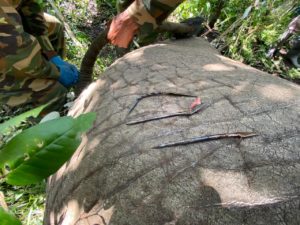 On June 15, MEP in partnership with KWS collared a bull elephant, Shamba, that was injured after being caught in farms by rapidly rising waters across the Mara River. In addition to his new collar, KWS Vet Dr. Limo and the Sheldrick Wildlife Trust Mara Mobile Vet Unit removed four arrows and treated a spear wound (pictured left). The satellite collar allowed us to not only monitor his recovery, but also react to his future crop raiding. This area has seen a high level of human-elephant conflict historically because it’s heavily populated with many people farming right across the Mara River from the Ol Choro Oiroua Conservancy, a safe place for elephants to roam. Shamba was monitored until his time of death 10 days later. On June 25, MEP received an immobility alert from his collar and the cause of death was determined by a KWS autopsy as most likely thromboembolism from the originally treated spear wound on his chest. While the team’s joint efforts to treat and collar this elephant to save his life weren’t successful this time, if the elephant had not been collared, we wouldn’t have gotten to the carcass quickly enough to identify the cause of death; an important data point to collect in the Mara to protect future elephants. The MEP team was able to recover Shamba’s elephant collar to re-deploy this year. Shamba’s story, while sad, represents a common one told in the Mara; the struggle between elephants and farmers continues. This is why KWS and MEP believe that collaring key elephant candidates in response to conflict is a successful approach in order to monitor their movements in real-time and collect important data for land use planning.
On June 15, MEP in partnership with KWS collared a bull elephant, Shamba, that was injured after being caught in farms by rapidly rising waters across the Mara River. In addition to his new collar, KWS Vet Dr. Limo and the Sheldrick Wildlife Trust Mara Mobile Vet Unit removed four arrows and treated a spear wound (pictured left). The satellite collar allowed us to not only monitor his recovery, but also react to his future crop raiding. This area has seen a high level of human-elephant conflict historically because it’s heavily populated with many people farming right across the Mara River from the Ol Choro Oiroua Conservancy, a safe place for elephants to roam. Shamba was monitored until his time of death 10 days later. On June 25, MEP received an immobility alert from his collar and the cause of death was determined by a KWS autopsy as most likely thromboembolism from the originally treated spear wound on his chest. While the team’s joint efforts to treat and collar this elephant to save his life weren’t successful this time, if the elephant had not been collared, we wouldn’t have gotten to the carcass quickly enough to identify the cause of death; an important data point to collect in the Mara to protect future elephants. The MEP team was able to recover Shamba’s elephant collar to re-deploy this year. Shamba’s story, while sad, represents a common one told in the Mara; the struggle between elephants and farmers continues. This is why KWS and MEP believe that collaring key elephant candidates in response to conflict is a successful approach in order to monitor their movements in real-time and collect important data for land use planning.
The second collaring MEP did was requested by KWS in response to conflict as well. In the Londiani area north of the Mau, “Ritan” was identified as a cropaholic elephant; going into farms around Deloraine on a nightly basis. The KWS ground team based in the area was vigilant about pushing him back into the forest when he breaks through the geo-fence we programmed around the forest. The collaring operation was an interesting exercise for the Karen Blixen Camp Trust helicopter as hovering at high altitudes during the darting pushes the helicopter to the edge of the power envelope. The mission was a great success and completed without incident.
Using Esri ArcGIS Pro software the MEP Research Department was able to develop an animation of crop-raiding behavior that was featured in a blog about their research into human-elephant conflict. The 3D animation technique is one of the most effective ways of visualizing tracking data and see what crop raiding looks like. In the animation, we see the three elephants hiding during daylight in forested ‘staging’ sites while raiding crops each night for a week in early 2017. Esri has generously renewed our organizational license for another year and Save The Elephants promoted MEP’s conflict blog on their vastly followed social media channels, which provided great exposure for our organization.
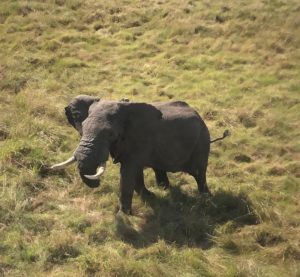 MEP aerially monitored Shorty who started June on the southern side of the Serengeti National Reserve then moved into Kenya near the border. (pictured left: Shorty photographed on June 26 during an aerial monitoring flight.) He was spotted with a mixed group of 15 elephants. Unfortunately, Chelsea’s collar battery lost power in June and will need to be replaced soon. Ivy continued her crop raiding behavior breaking geo-fences in the Enoonkishu area where MEP rangers needed to respond. Hannibal and Napoleon continue to spend time together moving around the Mosiro area and raiding farms at night. MEP’s two research assistants (Amos & David) have continued with their land-mapping exercise using MEP’s Njia mapping application. David is focused on collecting ground control points to help with a landcover classification while Amos is mapping the proliferation of fences spreading across the Loita plains.
MEP aerially monitored Shorty who started June on the southern side of the Serengeti National Reserve then moved into Kenya near the border. (pictured left: Shorty photographed on June 26 during an aerial monitoring flight.) He was spotted with a mixed group of 15 elephants. Unfortunately, Chelsea’s collar battery lost power in June and will need to be replaced soon. Ivy continued her crop raiding behavior breaking geo-fences in the Enoonkishu area where MEP rangers needed to respond. Hannibal and Napoleon continue to spend time together moving around the Mosiro area and raiding farms at night. MEP’s two research assistants (Amos & David) have continued with their land-mapping exercise using MEP’s Njia mapping application. David is focused on collecting ground control points to help with a landcover classification while Amos is mapping the proliferation of fences spreading across the Loita plains.
The Greatest Maasai Mara Photographer of the Year has launched an online auction platform selling beautiful images to raise much-needed funds for boots-on-the-ground conservation organizations in the Mara, like MEP. The Angama Foundation is ensuring 50% of all proceeds goes to the competition’s conservation partners so buyers can be assured that their funds are working to protect the Mara for generations to come. Elephanatics hosted a fundraiser for MEP selling elephant-themed wine. MEP received a 25-kilogram donation of seed balls from Seedballs Kenya courtesy of Filip.
MEP Monthly Report June 2020
Marc Goss went live on Facebook with The Nobelity Project for an hour-long conservation talk about MEP. Terra Conservation released a two-part podcast featuring Marc and Dr. Jake Wall. In the series, Terra highlights the stories of wildlife rangers on the frontlines of the fight against poaching, how technology is being used to support their efforts and what life is like for those who are creating sustainable economies for the vulnerable and at-risk populations who are protecting Earth’s most precious resources. An article from The Guardian featuring Mara Elephant Project’s rapid response to human-elephant conflict in Ol Kinyei Conservancy alongside head ranger Simon Nkoitoi. Marc is featured discussing the use of the KBCT helicopter to move elephants out of settlements and the challenges that come along with that. Additionally, we were featured in Corporate Knights magazine discussing COVID-19 and how it’s impacting conservation. MEP’s Communications Director Claire Bolles and Trustee Trey Fehsenfeld presented at the Indianapolis Zoo for their Conservation Educator Academy. Afterwards, the elephant Conservation Station kiosk was unveiled at the Indy Zoo as part of their new elephant Tembo Camp. It features a video on MEP and the Indy Zoo’s supported elephant Vasco. We continue to value the relationship between MEP and the Indianapolis Zoo.
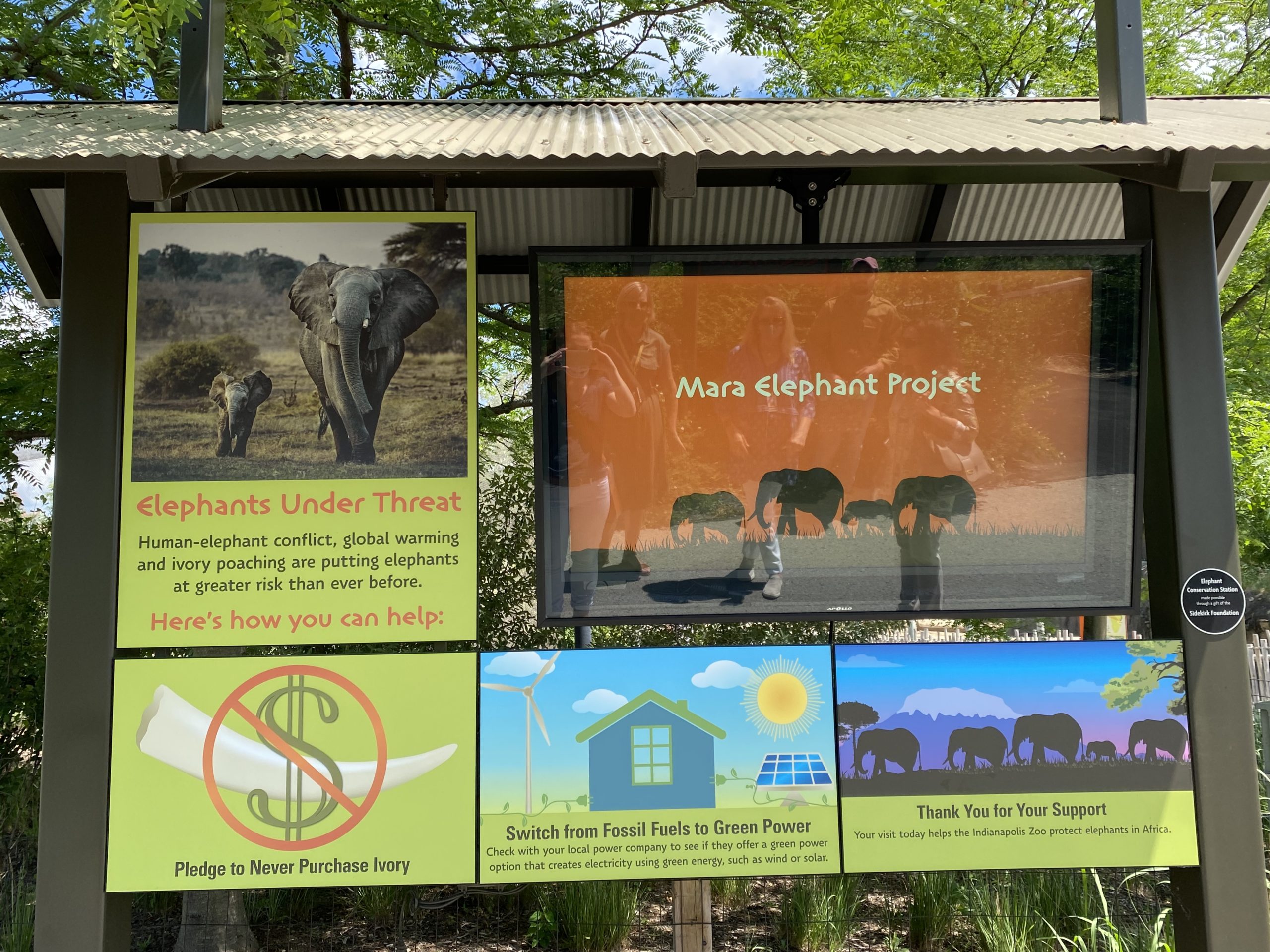
The Conservation Station at the Indy Zoo.
Paradise International Foundation, Jack Ma’s conservation organization, gave a generous donation of 20,000 surgical masks, 400 N95 medical masks and 100 infrared thermometers to support healthcare worker’s efforts at six partner medical facilities across the Maasai Mara, and the wider Narok West sub county: Aitong Health Center, Mararianda, Nkoilale, Olesere, Endoinyio Erinka and Talek. The Maa Trust supplemented these supplies with boots, protective overalls and on June 10, Mara Elephant Project joined them to hand over this essential COVID-19 PPE equipment to the Ministry of Health and Community Health Partners at Talek Clinic. Photographed are MEP CEO Marc Goss, MEP Data and Reporting Manager Wilson Sairowua and The Maa Trust CEO Crystal Mogensen along with Talek Clinic representatives.
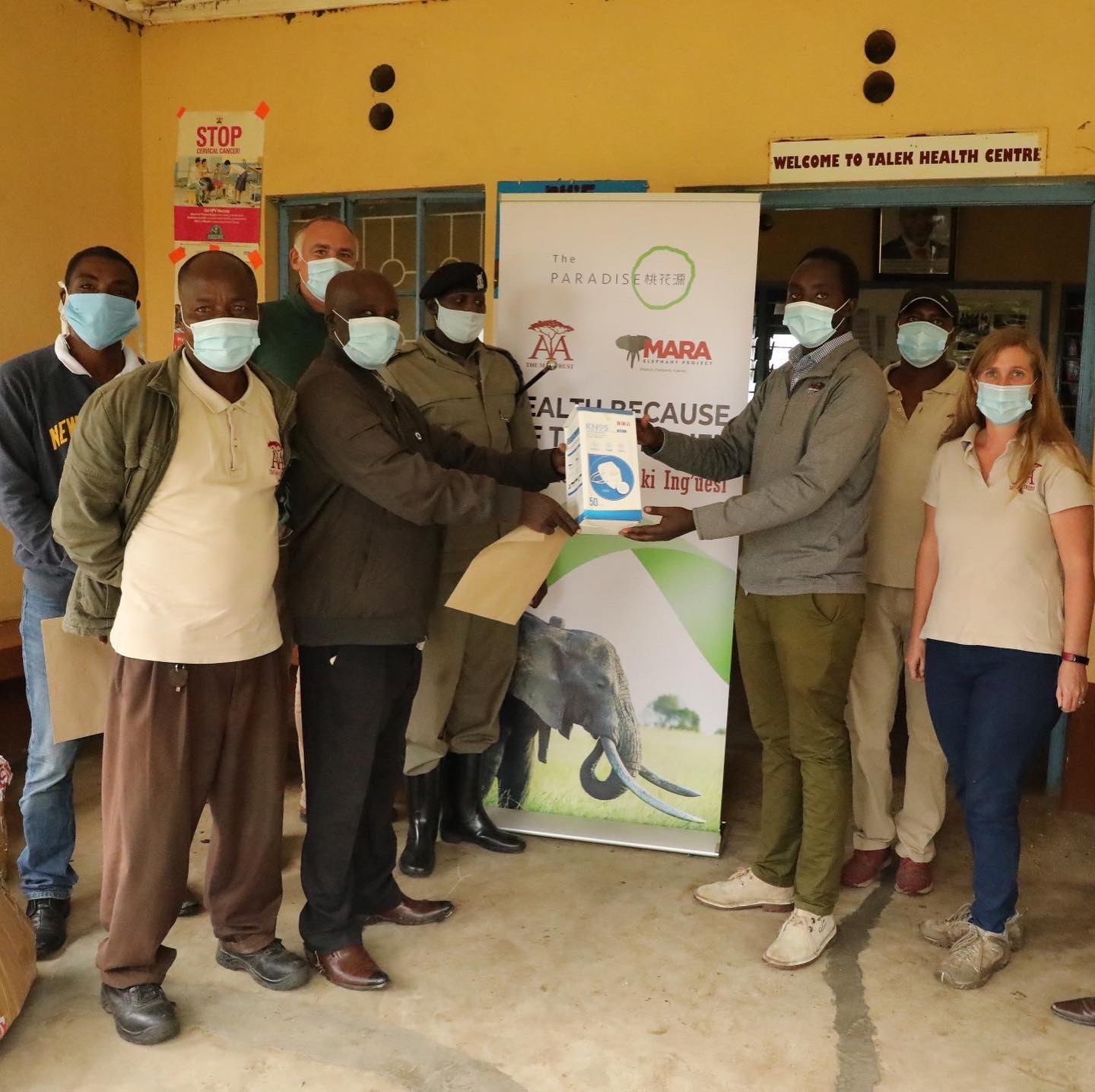
PPE distribution in June.
Thank you to every donor this month and everyone who supported MEP with an entry in the Greatest Maasai Mara photo competition in June.

A June entry by photographer Kelly Moran.


